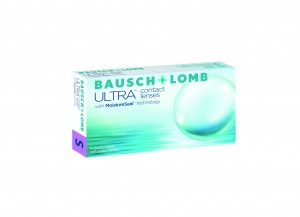Spending more time on digital devices may mean you are less satisfied with your contact lenses.2 Frequent use of a smart phone, tablet or computer may cause you to blink less, which could contribute to your contact lenses drying out.
In addition, you may experience symptoms such as:2
- Blurred vision
- Eye strain
- Tired eyes
- Delayed focusing
NEW! Bausch + Lomb ULTRA contact lenses with MoistureSeal technology – helps prevent lens dehydration that may be caused by reduced blink rates.4
Key Features & Benefits
NEW Bausch + Lomb ULTRA contact lenses with MoistureSeal technology Feature:
- MoistureSeal technology to help prevent lens dryness4
- Retain moisture for a full 16 hours3
- Provide superior end-of-day vision* for digital device users1
* Among the leading silicone hydrogel lenses
1. Results from a 22-investigator, multi-site study of Bausch + Lomb ULTRA contact lenses with MoistureSeal technology, on 327 current silicone hydrogel lens wearers. After 7 days of wear, subjects completed an online survey. Subjects rated performance across a range of attributes. Preference comparisons represent only those subjects expressing a preference. Ratio is based on the average across the silicone hydrogel lenses represented in the study.
2. Kadence International Exploring Contact Lens Drop-off May 2013
3. Data on file. Bausch & Lomb Incorporated. Rochester, NY; 2013.
4. Results of an in vitro study in which Bausch + Lomb ULTRA, ACUVUE OASYS, AIR OPTIX AQUA, and Biofinity contact lenses were placed on a model cornea with 0.18 μm of spherical aberration. Images were acquired every 10 seconds up to 30 seconds and analyzed using pattern matching algorithms. A score for each 10-second interval is determined by comparing how closely the test image matches the time 0 image. Mean scores over the 30-second interval were determined and compared.
